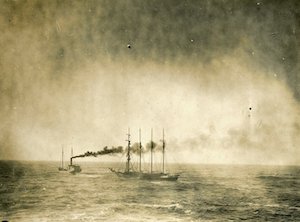
The Brooklyn towing a four-masted barkentine from Big River. (Gift of Emery Escola, Emery Escola Collection, Kelley House Photographs)
November 8, 1930 – The wooden steam schooner Brooklyn sank while crossing the Humboldt bar at the entrance to Humboldt Bay. Seventeen crew members were lost; only the first mate survived.
The Beacon reported, “The sea was extremely rough as the vessel attempted to cross the bar and the steamer suddenly turned over when hit by a huge wave and went down very shortly. The foundering of the vessel was witnessed from a distance by members of the Coast Guard crew and crew of another vessel that started to follow the Brooklyn to sea but turned back. Those observing the vessel’s action think that the ship captain when he found that the bar was running such a heavy sea attempted to turn back and that in doing so his vessel was caught broadside by a big comber and turned over.”
72 hours later, First Mate Jorgen M. Greve, the only survivor, was picked up by the fishing trawler, Two Sisters. Greve had clung to a 4’ by 8’ piece of bulkhead for 3 days despite the rough seas, his injuries, and lack of food or water.
Built in 1902 by J. Lindstrom of Aberdeen, Washington, for W. F. Higgins of San Francisco, the ship had a 250 horsepower, 2-cylinder compound engine built by Fulton Engine and Shipbuilding Works in San Francisco and had a capacity of 350,000 board feet of lumber. Early in her career, she was owned by Beadle Brothers of San Francisco and later owned by Sudden and Christenson.
“Thomas H. Petersen Master Shipbuilder” by Louis A. Hough. Thomas Petersen built about three dozen wooden vessels: sailing schooners, a barkentine, steam schooners, steam tugs and lighters. Based on Petersen’s memoirs. $15.